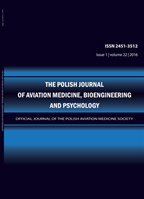2015, Volume 21, Issue 3
Flights with the Risk of Spatial Disorientation in the Measurements of Oculomotor Activity of Pilots
Rafał LEWKOWICZ1, Piotr FRANCUZ2, Bibianna BAŁAJ3, Paweł AUGUSTYNOWICZ2
-------------------------------------------------------------------------------------------------
1Aeromedical Training Division, Military Institute of Aviation Medicine
2Faculty of Social Sciences, Institute of Psychology, John Paul II Catholic University of Lublin
3Faculty of Humanities, Institute of Philosophy, Nicolaus Copernicus University in Toruń
Autor korenspondencyjny: Rafał LEWKOWICZ; Aeromedical Training Division, Military Institute of Aviation Medicine; email: rlewkowicz[at]wiml.waw.pl
Full text
Streszczenie
Introduction
To date, research on oculomotor predictors of the correctness of in-flight maneuvers depending on pilot’s expertise was never conducted in relation to situations involving the risk of spatial disorientation. This article describes the developed testing metod that facilitates the assessment of oculomotor activity upon spatial disorientation caused by visual or vestibular illusions.
Methods
The experiment will include a group of 20 male pilots (expert group) and 20 male nonpilots (novices group). The testing station consists of a Gyro-IPT spatial disorientation simulator and a mobile oculographic device for the measurement and tracking of subject’s oculomotor activity.
Results
The study allowed for the development of a set of flight profiles for the Gyro-IPT simulator as well as a verified testing procedure including oculographic device calibration as well as the measurement and tracking of flight parameters and eyeball movements.
Conclusions
Appropriate setup of the testing station and verification of the developed testing procedure will facilitate successful conduct of the planned experiment. Determination of efficient visual field scanning strategies for flights associated with the risk of spatial disorientation will constitute a significant contribution into aviation psychology as well as would possibly contribute to the development of more efficient pilot training programs as well as improvement of flight safety.
Słowa kluczowe
flight simulator, oculomotor activity, spatial disorientation
